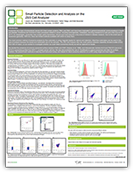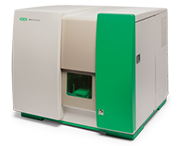Exosomes are a class of membrane secreted vesicles found in most bodily fluids. Typically 50–100 nm in size, they are involved in intracellular communication, metastasis, and antigen presentation, and carry important cellular information. They have become a source of increasing interest for potential novel biomarkers.
However, exosomes can be difficult to characterize and study due to their small size. The ZE5 Cell Analyzer is ideally suited for studying them though as it can be equipped with a small particle detector (SPD) that uses the 405 nm laser line and a separate forward scatter (FSC) PMT to help detect exosomes and other sub-micron particles. It also has a novel threshold plot that provides a raw signal from the trigger detector(s) and aids in discriminating noise and debris from the desired signal.
Exosome Discovery Resources
The following resources illustrate how the ZE5 Cell Analyzer can help you characterize and study extracellular vesicles.

Exosome Workflow

Exosomes can be detected using surface or intravesicular staining on the ZE5 Cell Analyzer. We share both methods, along with details of direct exosome detection and instrument setup, in this useful poster.
Small Particle Studies

In addition to performing small particle detection with ease, the ZE5 Cell Analyzer combines speed with enhanced electronics to perform rapid analysis without compromising data quality. Automation of crucial processes, such as washing the sample probe between samples, can reduce data variation. The low-noise electronics of the ZE5 Cell Analyzer also improves the quality and reproducibility of your experiments. Download this poster to learn how the ZE5 Cell Analyzer can help you do more.
Exosome Flow Cytometry Protocol

Want to learn more about exosome detection with the ZE5 Cell Analyzer? In this protocol, we share our methods for performing direct exosome detection and traditional bead-based exosome detection on the ZE5 Cell Analyzer. We also show that the marker proteins ALIX and TSG101, used to define exosome populations, are also detectable. Download the protocol to discover these methods for yourself.
Webinar: How to Detect Exosomes Directly

In this on-demand webinar, we demonstrate how the small particle detection capability of the ZE5 Cell Analyzer can be used for exosome detection. We also present the instrument setup for direct exosome detection and for detection of exosomes captured on beads.
Related Topics
Bio-Rad — experts in flow cytometry — can help you discover everything you need to conduct successful flow experiments with the following additional resources:
